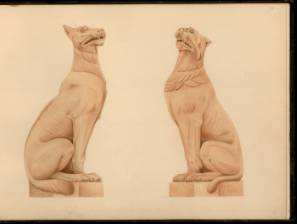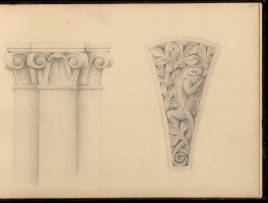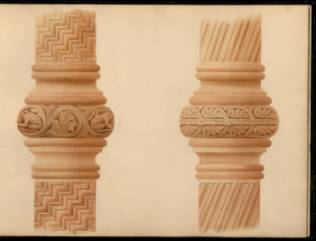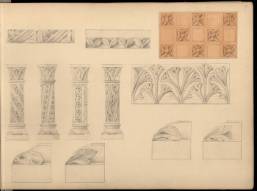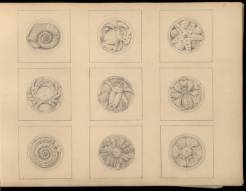It is a huge privilege to work in such a beautiful and truly fascinating building. Regardless of how long you work here, there is always something new to notice built into the fabric of the building, both inside and out. I firmly believe that you can never tire of this structure, and throughout the seasons of the year, its character actually changes. We have Alfred Waterhouse to thank for this.
The original winner in 1864 of the competition to design the building that would house the natural history collections of the British Museum and fullfill Richard Owen's vision, had been architect Francis Fowke. However, when he died a year later, Alfred Waterhouse was asked to take over, and he chose to put forward fresh designs and drawings. Work finally began on construction in 1873.
(Above) Two of seven animals that stand on the balustrades and gables of the pavilion.
Both living and extinct creatures are depicted in the fabric of the building both inside and out. When originally designed those on the external east side were extinct and those on the west side were living and indicated the nature of the galleries inside. On the whole this remains true for today's permanent galleries, except for the Dinosaur Gallery. Since the Museum opened in 1881 there are two animals that are now recognised to be on the wrong sides. The passenger pigeon is now extinct and the coelacanth has since been rediscovered.
The Library & Archives here at the Natural History Museum hold original Waterhouse detailed pencil drawings and some chalk colour wash drawings. The collection consists of 136 mounted drawings and one volume of 66 drawings.
The volume is a relatively recent acquisition to the collection and is described as 'Some details of the enrichments of the new Museum of Natural History (South Kensington) modelled by C. Dujardin for A. Waterhouse Esq. A.R.A. architect circa 1874-1879'.
(Above) Detail from inside the building including on the right an Iguana 'spandrel' in the Entrance to the Central Hall.
It was purchased in March 2003 from a collector of architectural drawings in France. He acquired the album 28 years previously in Angers from a book dealer who discovered it in the local flea market. The whereabouts of the album between the time Monsieur Dujardin presumably returned to this native France and its appearance in Angers is unknown.
Alfred Waterhouse (1830-1905) is well known as the architect of the Natural History Museum, built in the Romanesque style which opened to the public in 1881. Originally his Quaker family denied his chosen career as an artist, and therefore he trained as an architect, soon achieving acclaim for his support of the Gothic revival. He prepared the drawings in the album, for Monsieur Dujardin, foreman of Farmer and Brindley, the architectural modellers. Waterhouse worked up the drawings with the help of Sir Richard Owen, the Museum's first Superintendent, who loaned him actual specimens to ensure the accuracy of his designs. All of the drawings were checked by Owen before being passed to Dujardin.
By the end of his life Waterhouse had designed a significant number of public buildings, country houses, clubs and churches. After the Museum he is best known for Manchester Town Hall, the Prudential Insurance buildings in Holborn and Eaton House, Cheshire.
(Above) Detail of the 'shafts' that can be seen at the main entrance in the museum and in particular the foliage 'annulets' banded around them.
In this album there are 66 drawings, mostly pencil, but 10 have a colour wash applied to show the tone of the finished terracotta pieces. Over a third of the drawings are different from any of the master drawing set of 136, acquired in 1962 from Waterhouse's grandson. A further third are similar to other surviving drawings but show developments in the design process of the reliefs. Only 15 drawings exactly match those already held.
Examples of further reading:
Cunningham, C (2001) The terracotta designs of Alfred Waterhouse London: Natural History Museum
Cunningham, C & Waterhouse, P (1992) Alfred Waterhouse 1830-1905 : biography of a practice Oxford: Clarendon Press
Girouard, M (1981) Alfred Waterhouse and the Natural History Museum, London: British Museum (Natural History)
Holmes, J (2013) 'Building a vision of nature: Owen, Waterhouse and the design of the building', Evolve, Issue 17, Autumn pp.37-41
Visit the NHM Picture Library to view more examples of the terracotta designs.
(Above left and right) Further examples of flora and fauna detail that can be seen around the main entrance to the museum, in the Central Hall and along Dinosaur Way.



